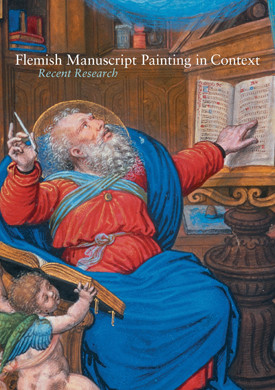
Flemish Manuscript Painting in Context: Recent Research
Edited by Elizabeth Morrison and Thomas Kren
2006
208 pages
PDF file size: 31.4 MB
Description
A companion to the Getty's prize-winning exhibition catalogue Illuminating the Renaissance: The Triumph of Flemish Manuscript Painting in Europe, this volume contains thirteen selected papers presented at two conferences held in conjunction with that exhibition. The first was organized by the Getty Museum, and the second was held at the Courtauld Institute of Art under the sponsorship of the Courtauld Institute and the Royal Academy of Arts. Added here is an essay by Margaret Scott on the role of dress during the reign of Charles the Bold.
Texts include Lorne Campbell’s research into Rogier van der Weyden’s work as an illuminator, Nancy Turner’s investigation of materials and methods of painting in Flemish manuscripts, and trenchant commentary by Jonathan Alexander and James Marrow on the state of current research on Flemish illumination. A recurring theme is the structure of collaboration in manuscript production. The essays also reveal an important new patron of manuscript illumination and address the role of illuminated manuscripts at the Burgundian court. A series of biographies of Burgundian scribes is featured.
Table of Contents
- Preface
- Part 1: Illuminated Manuscripts in the Burgundian Court
- Chapter 1: Jan van der Scaghe and Anne de Memere, the first Owners of the Hours of 1480 in the Abbey Library at Nová Ríše
Lorne Campbell - Chapter 2: The Undecorated Margin: The Fashion for Luxury Books without Borders
Catherine Reynolds - Chapter 3: A Very Burgundian Hero: The Figure of Alexander the Great under the Rule of Philip the Good
Chrystèle Blondeau - Chapter 4: The Role of Dress in the Image of Charles the Bold, Duke of Burgundy
Margaret Scott
- Chapter 1: Jan van der Scaghe and Anne de Memere, the first Owners of the Hours of 1480 in the Abbey Library at Nová Ríše
- Part 2: Techniques, Media, and the Organization of Production
- Chapter 5: The Suggestive Brush: Painting Techniques in Flemish Manuscripts from the Collections of the J. Paul Getty Museum and the Huntington Library
Nancy K. Turner - Chapter 6: Flemish Manuscript Production, Care, and Repair: Fifteenth-Century Sources
Lieve Watteeuw <
- Chapter 7: Rogier van der Weyden and Manuscript Illumination
Lorne Campbell - Chapter 8: On Relationships between Netherlandish Drawing and Manuscript Illumination in the Fifteenth Century
Stephanie Buck - Chapter 9: Flemish Illuminated Manuscripts: Assessing Archival Evidence
Jan Van der Stock
- Chapter 5: The Suggestive Brush: Painting Techniques in Flemish Manuscripts from the Collections of the J. Paul Getty Museum and the Huntington Library
- Part 3: Individual Illuminators
- Chapter 10: The Master of Fitzwilliam 268: New Discoveries and New and Revised Hypotheses
Gregory T. Clark - Chapter 11: Marketing Books for Burghers: Jean Markants Activity in Tournai, Lille, and Bruges
Dominique Vanwijnsberghe - Chapter 12: Iconographic Originality in the Oeuvre of the Master of the David Scenes
Elizabeth Morrison
Part 4: Directions for Further Research - Chapter 13: Scholarship on Flemish Manuscript Illumination of the Renaissance: Remarks on Past, Present, and Future
James H. Marrow - Chapter 14: One Hundred Years of the Study of Netherlandish Manuscripts
Jonathan J. G. Alexander
- Chapter 10: The Master of Fitzwilliam 268: New Discoveries and New and Revised Hypotheses
- Appendix
- Scribe Biographies
Richard Gay - About the Contributors
- Index
- Photograph Credits
About the Authors
Jonathan Alexander is Sherman Fairchild Professor of Fine Arts at the Institute of Fine Arts, New York University, where he teaches medieval art history. His special area of interest is manuscript illumination of the Middle Ages and Renaissance. His most recent books are Studies in Italian Manuscript Illumination (2002) and The Towneley Lectionary Illuminated for Cardinal Alessandro Farnese by Giulio Clovio (1997). He is now working on a book tentatively titled "Italian Renaissance Illumination c. 1450-1600."
Chystèle Blondeau received her Ph.D. in the history of art from the University of Paris X (Nanterre) in 2003 with a dissertation on representations of Alexander the Great at the Burgundian court. She specializes in secular iconography, issues of patronage, and the links between art and power. She teaches medieval art history at the University of Paris X (Nanterre) and elsewhere.
Stephanie Buck received her Ph.D. from the Freie Universität Berlin in 2000, and is currently adjunct professor at FU-BEST, Berlin, and a Getty fellow at the Friedrich-Alexander Universität Erlangen-Nürnberg. She has contributed to a critical catalogue of fifteenth-century Netherlandish drawings in the Kupferstichkabinett, Berlin (2001), and to an exhibition of fifteenth- and sixteenth-century German drawings at the Graphische Sammlung, Städel, Frankfurt am Main (2004).
Lorne Campbell is George Beaumont Senior Research Curator at the National Gallery, London. His many publications include National Gallery Catalogues: The Fifteenth Century Netherlandish Schools (1998) and Renaissance Portraits (1990).
Gregory T. Clark is professor of art history at the University of the South in Sewanee, Tennessee. He has published numerous studies on French and southern Netherlandish manuscript illumination of the fifteenth century. His most recent book is The Spitz Master: A Parisian Book of Hours (2003).
Richard Gay is assistant professor of art history at the University of North Carolina, Pembroke. Formerly assistant curator of manuscripts at the J. Paul Getty Museum, he helped prepare the exhibition and contributed to the publication of Illuminating the Renaissance: The Triumph of Flemish Manuscript Painting in Europe (2003). His special interest is French manuscript illumination, and he has published previously on Flemish scribes.